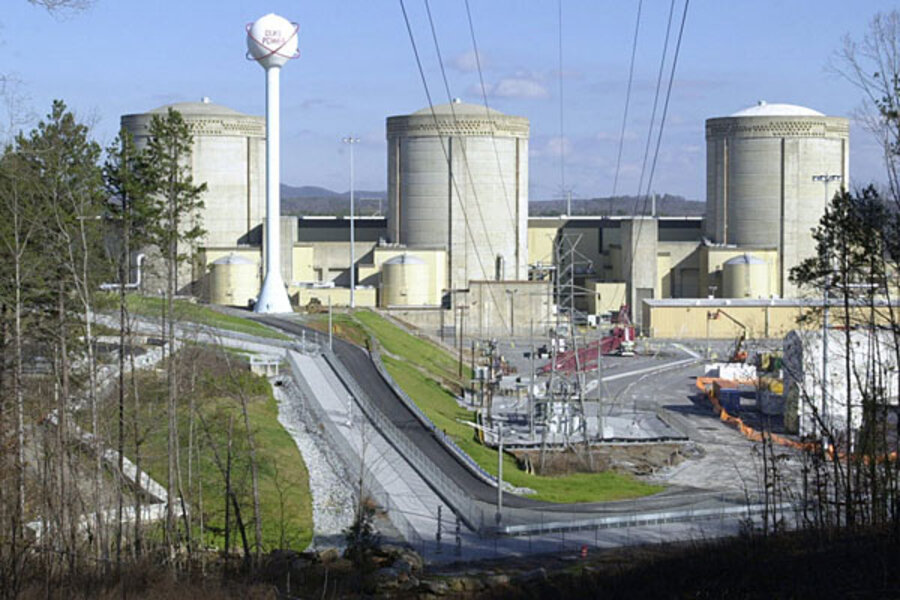NRC hearing raises questions about safety at nuclear plants
Loading...
A Nuclear Regulatory Commission hearing offered fresh findings in the runup to a final 90-day safety review report on the US nuclear fleet due next month.
A safety task force staff told the five-member commission that America's nuclear plants were safe, but noted that:
• In many cases, older "vintage" plants that undergo relicensing examinations to operate an added 20 years are not required to bring those plants fully up to current safety standards
• NRC regulations have never formally recognized the possibility of an extreme event – like an earthquake or tornado – simultaneously knocking out both on-site and off-site power at a nuclear plant, as happened at the Fukushima Daiichi plant in Japan.
• The nation's nuclear plants have "different licensing bases and associated safety margins," with variations among the plants depending upon their age.
• "Hardened vents" installed to protect US boiling water reactors with the same design as the Fukushima plant were "not included in regulations" and, as a result, were not subject to regular inspections to ensure that they operate properly in an emergency.
• Key valves associated with the hardened vents "were not specifically designed for operation during a long-term station blackout" and therefore might be difficult to open in the event of a Fukushima like incident. [Editor's note: The original version misstated the task force's finding on this point.]
During his presentation, the team leader of the 90-day task force, Charlie Miller, noted multiple times that older power plants were not necessarily required to be upgraded or retrofitted to meet newer safety standards or a better understanding of environmental threats like earthquakes as knowledge about them grew.
"We just wanted to point to the fact that various vintage plants, based on what the knowledge was at the time, were licensed to those things," Dr. Miller said in his report. "The design basis for those plants were set at the time – at the time that they were licensed – and it's variable across the spectrum of the plants depending upon their vintage.
Later in the meeting, NRC Chairman Gregory Jaczko asked whether the task force had considered the possibility that the relicensing process that permits older plants to operate an added 20 years might need to be toughened.
"At license-extension time we have an opportunity, although the commission has not availed itself of that opportunity, to in a sense re-baseline everybody's design basis or licensing basis at this point," Dr. Jaczko said, "so everybody at that point has a consistent understanding of what is the definition of safety, what is the definition of external hazard? Is the task force looking at that at all as a specific way to address this?"
Miller noted that additional requirements have indeed been made at a number of older plants to ensure safety, but are not part of the license-renewal process.
"We believe the plants are operated safely, but it's like any technology, a newer version of its going to have more features," Miller said. "We have a recognition that you can't go and rebuild the plant."
Bill Borchardt, executive director for operations at the NRC added that "when you get into events like Fukushima, of having multiple initiating events ... that goes beyond what we routinely look at. That would require a commission decision to go beyond the current licensing basis and the current regulatory structure."
Still, sentiment globally may be shifting on how older plants are treated. Germany, which has announced it will close its fleet of 17 nuclear plants, has already closed seven older plants.
When new safety issues emerge, nuclear plants – old or new – undergo an NRC "back fit" review to see if additional safety requirements should be imposed, notes Edwin Lyman, a nuclear expert at the Union of Concerned Scientists, a nuclear industry watchdog group. But any back fit, unless required by existing regulations to bring a facility into compliance, must pass a cost-benefit test they often fail, ending with the recommended changes not being made, Dr. Lyman says. That position runs counter to rising concerns among international experts.
Earlier this month in a letter to the International Atomic Energy Agency, a 17-member ad hoc group of nuclear power experts and former regulators from 11 nations called for stress tests on the world's reactors to determine their ability to stand up to extreme natural disasters like earthquakes and floods. Older reactors, the letter noted, needed special oversight, and if they could not meet contemporary standards, should be closed, it said.
At the hearing, other safety issues also popped up that raised questions about whether the NRC's regulatory system was as tight as it has been portrayed. Miller's testimony that the "hardened vents" were were not part of an inspection regime to ensure they would function in an emergency was in contrast to NRC assurances early after the Fukushima event.
"It really shows the emperor has no clothes," Dr. Lyman of UCS says. "As it turns out, Japan also had hardened vents, but had issues accessing and opening valves. Now the NRC is admitting they don't have hardened vent inspections. As a result, they haven't actually analyzed the issue of the functionality of the system in extreme events."





